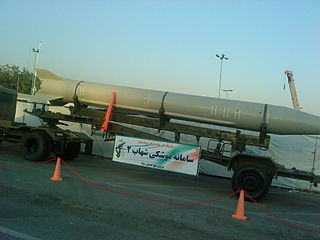Facts
| Designation | Shahab-2 |
| Missile Variants | Scud-C (Russia) |
| Mobility | Road Mobile |
| Designer/Producer | Iran/ North Korea |
| Range | 500 KM |
| Warhead Type and Weight | HE/ 770KG |
| MIRV and Yield | No MIRV |
| Guidance System/ Accuracy | /CEP 500 meters |
| Stages/ Propellant | Single/ Liquid |
| IOC | 1997 |
| Status/ Number of Units | Unknown |
Development
The Shahab-2 is a short range ballistic missile derived from the SCUD-C. The Shahab-2 has a maximum range of 500km (310 miles), making it capable of striking several urban areas and military sites near Iran’s borders. The Shahab-2 is liquid fueled, and can typically carry a nuclear or conventional high explosive warhead with a payload of around 770kg. [1] As a road mobile system, the Shahab-2 can be launched from any location. With help from North Korea, Iran acquired the ability to produce the Shahab-2 domestically in the early 1990s. [2] North Korea continued to help Iran develop the Shahab-2, but Iran also sought technical assistance from China and Russia. [3] By 1997, Iran reportedly established the capacity to produce the Shahab-2 missile, though they are still reliant on foreign missile components. [4]
Moreover, the Shahab-1 and 2 have some commonality in their overall structural dimension, and mechanical parts. [5] However, the major difference between the Shahab-1 and 2 is the weight of their warheads. The Shahab-2 is about 200kg lighter than the Shahab-1, which means that given the Shahab-2’s payload reduction, its range can be extended to about 200km more. [6]
 Strategic Implications
Strategic Implications
Like the Shahab-1, the Shahab-2 also poses a threat to the Middle East. The Shahab-2 has the capability to hold U.S. military installations and cities near Iran’s borders at risk. Since the late 1980s, Iran has used the Shahab-2 against military targets. In the war with Iraq in the late 1980s, Iran extensively used the Shahab-2, along with the Shahab-1. Furthermore, Iran was accused of using the Shahab-2 missile, including the Shahab-1, against the Mojahedine-Khalq Organization’s (MKO) Ashraf base just north of Baghdad in 1994. [7]
[1] Missile Threat. “Shahab 2 (‘Scud C’ Variant).” Last modified March 1, 2014. http://missilethreat.com/missiles/shahab-2-scud-c-variant/.
[2] International Institute for Strategic Studies. Iran’s Strategic Weapons Programmes: A Net Assessment. London, UK: Routledge, 2005, pg. 96.
[3] Ibid, 97.
[4] Ibid.
[5] Ibid.
[6] Ibid.
[7] Ibid.
